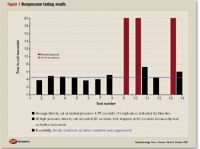Article
Cavitation necessary to produce efficient phaco
Author(s):
Las Vegas-Laboratory experiments involving an overpressurization technique have demonstrated that acoustic transient cavitation is necessary to produce efficient phacoemulsification, according to Mark E. Schafer, PhD, speaking here at the annual meeting of the American Academy of Ophthalmology (AAO).

Dr. Schafer, president and principal scientist, Sonic Tech Inc., Ambler, PA, conducted the experiments at typical clinical device conditions, using a specialized overpressure chamber that completely suppressed cavitation from the phaco handpiece.
"Efficient cavitation gives you efficient emulsification," he said. "Efficient means not only breaking up the cataract but also easy aspiration with no clogs, which produces a quieter eye."
Cavitation is controversial in the phaco community, although it is widely accepted in other applications involving ultrasonic surgery, such as thrombectomy, neurosurgery, or bone-cutting, Dr. Schafer said.
Describing himself as "being in the cavitation camp," Dr. Schafer acknowledged that softer cataracts can be dissolved with mechanical, jackhammer vibration.
"But I believe to be really efficient at it, you need cavitation, because cavitation is such an effective cutting tool," he added.
To investigate the cutting effectiveness of phaco when cavitation was suppressed, he set up an experiment in which he could monitor the cutting and measure the time it took to make a 5-mm plunge cut into custom artificial lens material (ethylene acrylate, ~3+ equivalent).
"I set it up that way because the force required for plunge cutting is strictly the weight of the handpiece, which is not a lot," Dr. Schafer said. "I didn't want to put a lot of force onto the tip because that would not be clinically relevant."
Experiment details

Phaco equipment included a Sovereign Compact with WhiteStar (Advanced Medical Optics) system; the handpiece has a 19-gauge, 0° tip.
The first step in the experiment was baseline testing under normal conditions. The handpiece was positioned and locked in place with a remote-releases solenoid gripper above the target then energized at 20%, 6 ms on/12 ms off, which is a typical clinical setting. When the solenoid was released, gravity produced a gentle applied force at the tip of the solenoid-released handpiece. Dr. Schafer then observed and recorded the time to penetrate 5 mm in the artificial lens material.
Newsletter
Don’t miss out—get Ophthalmology Times updates on the latest clinical advancements and expert interviews, straight to your inbox.




